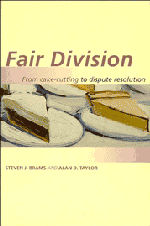Book contents
- Frontmatter
- Contents
- List of figures
- List of tables
- Acknowledgments
- Introduction
- 1 Proportionality for n = 2
- 2 Proportionality for n > 2: the divisible case
- 3 Proportionality for n > 2: the indivisible case
- 4 Envy-freeness and equitability for n = 2
- 5 Applications of the point-allocation procedures
- 6 Envy-free procedures for n = 3 and n = 4
- 7 Envy-free procedures for arbitrary n
- 8 Divide-the-dollar
- 9 Fair division by auctions
- 10 Fair division by elections
- 11 Conclusions
- Glossary
- Bibliography
- Index
1 - Proportionality for n = 2
Published online by Cambridge University Press: 05 July 2011
- Frontmatter
- Contents
- List of figures
- List of tables
- Acknowledgments
- Introduction
- 1 Proportionality for n = 2
- 2 Proportionality for n > 2: the divisible case
- 3 Proportionality for n > 2: the indivisible case
- 4 Envy-freeness and equitability for n = 2
- 5 Applications of the point-allocation procedures
- 6 Envy-free procedures for n = 3 and n = 4
- 7 Envy-free procedures for arbitrary n
- 8 Divide-the-dollar
- 9 Fair division by auctions
- 10 Fair division by elections
- 11 Conclusions
- Glossary
- Bibliography
- Index
Summary
Biblical origins
In the Hebrew Bible, the issue of fairness is raised in some of the best-known narratives. Cain's raging jealousy and eventual murder of Abel is provoked by what he considered unfair treatment by God, who “paid heed” to Abel's offering but ignored his (Gen. 4:4). Jacob, after doing seven years of service in return for Laban's beautiful daughter, Rachel, was told that his sacrifice was not sufficient and that he must instead marry Laban's older and plainer daughter, Leah, unless he did seven more years' service, which he regarded as not only breaking a contract but also flagrantly unfair. Fairness triumphed, however, when King Solomon proposed to divide a baby, claimed by two mothers, in two. When the true mother protested and offered the baby to the other mother (whose baby had died), the truth about the baby's maternity became apparent, and “all Israel … stood in awe of the king; for they saw that he possessed divine wisdom to execute justice” (1 Kings 3:28).
Solomon's proposed solution is the first explicit mention of fair division that we know of in recorded history. But it is, of course, no solution at all: Solomon had no intention of dividing the baby in two. Instead, his purpose was to set up a game between the two women, described in Brams (1980, 1990b), that would distinguish the mother from the impostor.
- Type
- Chapter
- Information
- Fair DivisionFrom Cake-Cutting to Dispute Resolution, pp. 6 - 29Publisher: Cambridge University PressPrint publication year: 1996



